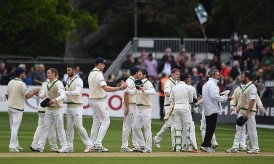The Four Day Follow On
Gulu Ezekiel |
When can a side be asked to follow on when the run difference on first innings is less than the standard 200 runs? When there is no play on the first day, usually for weather reasons reducing the match to four days.
As per the Laws of the game, the follow-on target is then brought down to 150 runs. And last week’s Test match between Pakistan and Ireland was one of the very rare occasions this has happened since the first occasion in 1971.
Pakistan after declaring on 310 for 9, dismissed hosts Ireland for 130 on the third day at Malahide, Ireland’s maiden Test match which they eventually lost by five wickets on Tuesday.
With a lead of 180 Ireland were asked to bat again by Pakistan skipper Sarfraz Ahmed as the first day’s play had been washed out on Friday, reducing this effectively to a four-day Test. In a standard five-day Test the target is a minimum of 200 runs.
The first time this happened was at Kingston, Jamaica in the first Test between India and West Indies (Feb. 18-23, 1971) when the opening day’s play was washed out.
It was Indian skipper Ajit Wadekar’s first Test as captain and the first time India had forced their formidable opponents to follow on.
Thanks to 212 by Dilip Sardesai—the first double century by an Indian batsman on foreign soil—India totaled 387 in their first innings. They then dismissed the home side for 217 with off spinner EAS Prasanna claiming 4 for 65 including the prized wicket of skipper Garry Sobers for 44.
Following on 170 runs behind, Windies saved the Test with veteran Rohan Kanhai remaining not out on 158 as they ended the Test on 385 for five.
The circumstances surrounding the follow on were certainly dramatic as narrated by Wadekar in his 1973 autobiography My Cricketing Years. “There was a stunned silence in the West Indies dressing room when I asked them to follow on.” For the mighty Caribbeans it was utter humiliation as India were then considered one of international cricket’s lightweights.
It transpired that Sobers was unaware of the rules regarding the follow-on when there is no play on the first day and initially challenged Wadekar’s decision. It was only after consulting the two umpires that he realized the Indian captain was right after all and had no choice but to comply. The trauma of following on left a deep scar on the psyche of Sobers and his team and there were even calls for his sacking after the Kingston Test.
Wadekar was aware of this effect, as narrated in his book, and had overruled his teammates who felt it was better to utilize the time left in the Test for batting practice.
This played a large part in India winning the second Test at Port of Spain, Trinidad, the first time they had beaten West Indies and that too on their own soil. India hung onto the 1-0 lead, drawing the next three Test matches to record their maiden series victory against Windies and only the second abroad since beating New Zealand 3-1 in 1967-68 under the captaincy of Tiger Pataudi.
That same year India also beat England for the first time in England, claiming the series 1-0 after sensationally winning the third and final Test at the Oval. But Kingston and that follow-on decision was what set the ball rolling for the year that changed the history of Indian cricket.
Between Kingston 1971 (Test match number 680) and Malahide 2018 (Test match number 2303) there has been one other instance when the first day’s play was washed out and the follow-on target was reduced and that was at Lord’s in 2001 when England led Pakistan by 188 runs in the first Test. England scoring 391 led Pakistan by 188 runs, forced them to follow on and won by an innings and 9 runs.
Later that same year at Hamilton there was another case where New Zealand led Bangladesh by 160 runs, enforced the follow on and won by an innings and 52 runs. This Test was peculiar and unique however in that the first two day’s play was washed out without a ball being bowled, reducing the match to three days where the follow on rules are the same as a four-day match.
–An earlier version of this piece stated the Malahide Test follow-on was only the second since 1971. It has been updated and corrected.






Leave a comment